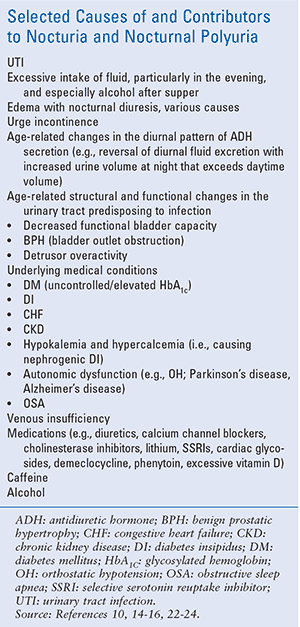

Several studies have explored even more severe consequences of nocturia, and a meta-analysis of 28,366 patients found that nocturia was associated with a 28% excess mortality risk per year Falls and bone fractures have been reported to occur at higher rates among those with nocturia these events may occur during the day because of fatigue caused by nocturia or during the night when individuals rise to voidġ2. Sleep interruption has numerous negative consequences for those with nocturia, including daytime fatigue, difficulty concentrating, mood alterations, and decreased workplace productivityġ1. The first nocturnal void in particular has the potential to lower sleep quality, since it may occur during the first few hours of sleep, interrupting the restorative slow-wave sleep that takes place during this time In a cross-sectional analysis of the Sleep Heart Health study, patients with nocturia reported higher degrees of subjective sleepiness and had corresponding polysomnographic changes that indicated objectively worse sleep qualityĩ. A multivariate analysis of elderly individuals (55–84 years of age) interviewed by the National Sleep Foundation showed that nocturia was an independent predictor of self-reported insomnia and poor sleep qualityĨ. A classification scheme for nocturia is presented and corresponding management strategies for each category are discussed.īy definition, nocturia results in sleep interruption, and thus it is axiomatic that this condition is associated with lower sleep quality. This article aims to review the prevalence of nocturia along with its clinical consequences. Unfortunately, many individuals do not seek medical consultation for nocturia because of the perception that it is a normal part of aging or even that it is untreatable Furthermore, this study demonstrated that nocturia is associated with impaired health-related quality of life (HRQoL) as measured by the generic 15D HRQoL instrumentĤ. The Finnish National Nocturia and Overactive Bladder (FINNO) study found that the majority of people report having at least moderate bother when they experience three or more nocturnal voids and that the degree of bother increases with the number of nightly voidsģ. Part of the controversy over the original definition stemmed from the fact that there may be no “complaint” from those who wake only once during the night to void, as a single episode of nocturia may not be bothersome at all. There has since been much debate around this definition, and it was revised in 2017 to be “waking to pass urine during the main sleep period”Ģ. In 2002, the International Continence Society (ICS) defined nocturia as “the complaint that the individual has to wake at night one or more times to void”ġ.
NOCTURNAL POLYURIA IN YOUNG ADULTS FULL
Once this urine is passed to the bladder, it wakes you up during the night with a full bladder.Nocturia is a prevalent and highly bothersome lower urinary tract symptom (LUTS). This is because, when you lie down, the water which causes the puffiness passes into the bloodstream and is converted into urine by the kidneys. Many people develop swelling or puffiness of the ankles in the evening but notice that they are normal, or less puffy, in the morning. you use the night-time to get rid of any excess water from your body.you drink too much in the evening this may include eating foods with a high water content (eg fruit, vegetables, salads, pasta & rice).you may not be producing enough ADH (vasopressin).When you produce too much urine overnight (ie more than one third of the daily total), this is called nocturnal polyuria. When you are young, ADH reduces urine production so that you produce less than a fifth of the 24-hour total at night.Īs you get older, especially after the age of 65, you should still be producing less than a third of your total urine output at night. This chemical is called antidiuretic hormone (or ADH). The body normally produces a chemical from the brain at night which tells the kidneys to cut down the amount of urine produced whilst you are asleep.


 0 kommentar(er)
0 kommentar(er)
